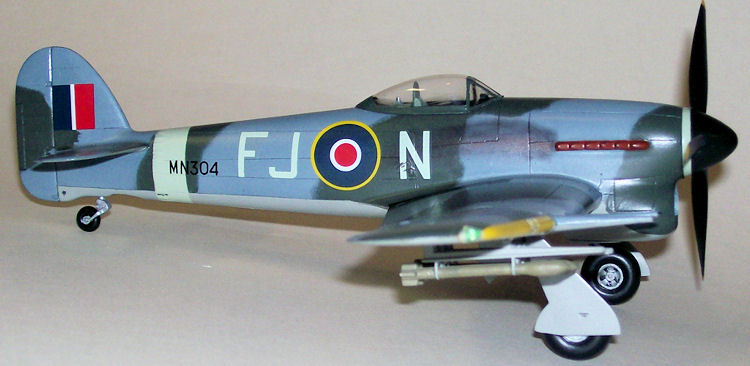
| KIT #: | 5221 |
| PRICE: | $ |
| DECALS: | One option |
| REVIEWER: | Pablo Calcaterra |
| NOTES: |
Part
|

| HISTORY |
Little was known about the
involvement of Argentine volunteers in the RAF, RCAF and RN until Oscar Raimondi
started his research work a few years ago along with Claudio Meunier who
continued and enhanced this project after Raimondi’s death.
There were almost 1,000 Argentine volunteers
that joined the flying forces during World War II. Most of them were descendants
of British people living in Argentina (i.e. working in the Great Southern
Railways) and thus their names are, no doubt about it, British. But there are
many other volunteers that have Spanish names and yet joined the RAF, RCAF and
RN. They flew in every theater of operations and flew practically all the planes
available (from bombers to fighters to transport to trainers). Some of them
remained in
During WWII the British community in
For the 164 Spitfire period check Part I . For the 164 Hurricane period check Part II.
Typhoon phase for 164 Sqn:
This
article has bits of information gathered here and there (see references) and it
is a little bit sketchy. But it is probably the most complete one yet published
about 164 Sqn during the last year and half of the war.
In January 1944 and being led by Sqn Ldr
Humphrey Russell
First Typhoon missions against German
targets were flown in March, radar sites being the most significant ones.
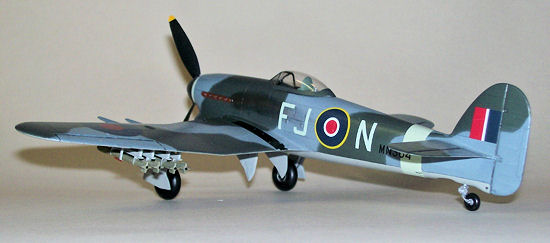 During one mission on May 28th
against a radar site in the Fruges area Sqn Ldr Russell destroyed the target
with his well-placed rockets but at the same time his Tiffie (FJ-L / JR515) was
hit by the intense flak. Climbing to 4,000 ft he told his men he was going to
bail out, left his plane and became a POW. Flt Sgt Fisher’s plane was hit in the
cockpit but he was not injured.
During one mission on May 28th
against a radar site in the Fruges area Sqn Ldr Russell destroyed the target
with his well-placed rockets but at the same time his Tiffie (FJ-L / JR515) was
hit by the intense flak. Climbing to 4,000 ft he told his men he was going to
bail out, left his plane and became a POW. Flt Sgt Fisher’s plane was hit in the
cockpit but he was not injured.
Sqn Ldr Percival Beake then took over the
Squadron first at Funtington, a satellite airfield just North of Thorney
Another type of Argentine volunteers where
the women that flew in Ferry Comand. One of them, Maureen Dunlop (born in
In the month between May and June the
squadron flew 139 sorties.
Based in Hurn during June and
July 1944 164 Sqn became part of No.136 Wing; No.84 Group; Second Tactical Air
Force; Allied Expeditionary Air Force.
While the attention of pilots was centered
on the ground targets two Fw-190 almost caught the squadron unaware. Luckily F/O
Dean gave the warning. Turning to gain the tail of a Focke Wulf F/L Todd fired a
burst that hit the drop tank of the German fighter. The flaming tank was
released but it was already too late and yellow flames were licking the
fuselage. While in a wide turn the German pilot opened the hood and jumped clear
of this doomed plane that crashed in a farm.
At 17.30 ten planes took off and minutes
later they were flying low in the Bayeaux area searching for more targets. A
small group of German vehicles was crossing a metal bridge over a small river.
Diving against them the 164 Sqn pilots made short work of their enemies. But the
Germans could bite too and F/O Robert’s plane was hit, lost a wing and the out
of control plane (MN466) hit the ground at 700 km/h killing the pilot.
After the exhausted pilots returned from
their second mission, and saddened by the loss of their friend, Beake was called
to the phone. Yet another mission was requested! So at 21.15 nine planes took
off and patrolled the Lisiseux-Caen-Falaise area. An Advance Air Controller led
them to another German convoy. Freddie Greene attacked first in almost darkness
and again the Typhoons made short work of vehicles and soldiers. This time there
were no losses…but after landing close to
Onwards:
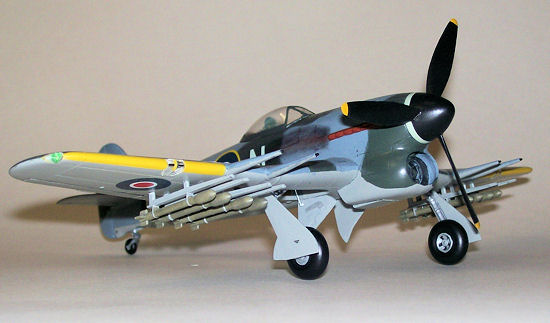 The next significant even took place on June
8th when Winco Bryan (in MN415) led his section low over the ground
searching for targets. After firing their rockets and destroying a locomotive he
saw twelve 109s diving to the attack. His section was low but the covering
section led by F/L A. Todd in FJ-Y caught the Messerschmitts by surprise. Todd
and F/S Wilson got 300 yards behind a 109 and their guns shot down the fighter.
Wing Commander Bryan damaged two more 109s.
The next significant even took place on June
8th when Winco Bryan (in MN415) led his section low over the ground
searching for targets. After firing their rockets and destroying a locomotive he
saw twelve 109s diving to the attack. His section was low but the covering
section led by F/L A. Todd in FJ-Y caught the Messerschmitts by surprise. Todd
and F/S Wilson got 300 yards behind a 109 and their guns shot down the fighter.
Wing Commander Bryan damaged two more 109s.
Tragedy struck 164 two days later. While
attacking yet another German column of vehicles, flak hit Bryan’s Typhoon and
the pilot was killed when the plane exploded. It was a heavy price to be paid
for 10 German vehicles destroyed. The Anglo-Argentine Brownrigg was posted to
183 Sqn on this day.
On June 20th a train station in
Caen was attacked by 164 Sqn at dusk. The remaining Anglo-Argentine Freddie
Greene was among the pilots that took part in this mission. One of the salvoes
hit a train loaded with ammo and the following day a recco Mosquito brought back
pictures that showed just a huge hole on the ground.
Sqn Ldr Beake tells us first-hand what
happened on June 24th. The mission was flown from Hurn via Needs Oar
Point, an
“My
most memorable combat mission of the war was an attack we carried out on a
German Army HQ in a chateau at St. Sauveur Endelin on 27th June 1944 (it
actually was near Saint-Sauveur-Lendelin, North of Coutances in the Cherbourg
peninsula – Anthony Knight). At the time I was OC 164 Squadron stationed at Hurn
and living under canvas. We had been released at midday but, notwithstanding
that, a signal was brought to me in the Mess tent where we were having lunch
requiring four aircraft to be sent to Needs Oar Point to take part in an evening
operation.” “I was disappointed and annoyed for, having released the squadron, I
now had to countermand that for some. I summoned up my two Flight Commanders,
told them the situation and said that I wanted two pilots from each flight ~
volunteers preferably but, if necessary, they would have to detail
participants.” “Although only a section of four was required, I made it a
practice to take a „spare‟ with me part way so that if anyone had to drop out
with engine trouble, or for any other reason, in the early stages of the mission
I had an airborne replacement I could call on. If I considered everything was
going well I would waggle my wings and the „spare‟ would return to base.”
“Having eaten I gathered the four nominated pilots together and went to
dispersal where we donned our flying kits and took off for the 15 minute flight
to Needs Oar Point. On the way there my airscrew developed an oil leak. On
landing I was warmly greeted by members of 193 squadron with whom I had been a
Flight Commander from its formation to three months previously. One pilot
climbed up to me in the cockpit and, seeing the oil on the windscreen, said “I
certainly wouldn’t take this kite if I were you, boss” (This was "Killy"
Kilpatrick of 193 Squadron and Anthony Knight’s uncle). “We were eventually
called in to the briefing where we were told what the target was and shown a map
for its location. The general plan was for eight „Bombphoons‟ (Typhoon Bombers)
in two sections of four to go in first at low level, I had to follow with my
rocket firing section and the last sixteen would dive bomb from high level to
finish off the attack. The low level bombs would be fitted with 11 second delay
fuses. Coming from the briefing all of my thoughts were negative and for some
reason my confidence was at an all-time low.” “I was still suffering annoyance
at having been called on when already released, my aircraft had developed an oil
leak and could be termed unserviceable, our target would undoubtedly be very
heavily defended, I had neither the surprise element of the low level bombers to
protect me nor the partial protection of height afforded to the dive bombers. In
fact I was beginning to think this may well be my last “op‟. “We took off as
planned and these thoughts were running through my mind as I watched the specks
of oil gathering on my windscreen. How much oil was I losing and how much could
I afford to lose ~ thinking of the 90 odd miles of water we had to cross before
reaching France and of the fading daylight that would not leave a lot of time
for rescue if I had to bail out. These thoughts nagged at me and I was sorely
tempted to call in my „spare‟ and turn back to safety. But no! If I did that and
any of my four failed to return I would find it very hard to live with myself so
I waggled my wings and my „spare‟ broke away to return to base.” “We arrived in
the target area at 9.30pm. The first section of four low level bombers was led
by W/Co Baldwin and the second section in had to allow at least an 11 second gap
before going in to avoid being blown up by the bombs of the first section.
Similarly I had to allow a like interval after the second section had gone in
before diving down and releasing my rockets. When the first bombs were dropped
flak erupted from all around with tracer shells showing up starkly in the
gathering dusk. By the time it was safe for me to lead my section down the flak
was tremendous and, looking down, it seemed quite impossible for anyone to dive
down into that inferno without getting hit ~ but we did and there were no
casualties. The chateau and all that was within it was completely destroyed. We
withdrew over the Cherbourg Peninsula and made our way across the Channel to our
respective bases.” “So why was this so memorable to me? Firstly this was very
satisfying to have taken part in such a hugely successful operation without
sustaining any casualties. Secondly my confidence at the outset was at its
lowest point ever so that the cards seemed heavily stacked against my survival
and I really had to steel myself to stay with the formation in an aircraft
leaking oil and not knowing how serious that might become. I guess there was a
bit of self-satisfaction in that I had resisted the very strong urge to “chicken
out” even though there was a justifiable reason for doing so.”
During another ground attack mission on July
6th F/S Fisher’s engine started to falter and it hit the Channel. F/S
Fowell also was lost to flak but his body was never found. Fisher’s body was
retrieved from the water by HMS Lightfoot.
In July 1944 the Squadron
moved to France and was briefly based at B.8 Sommervieu and then at B.7
Martragny until September.
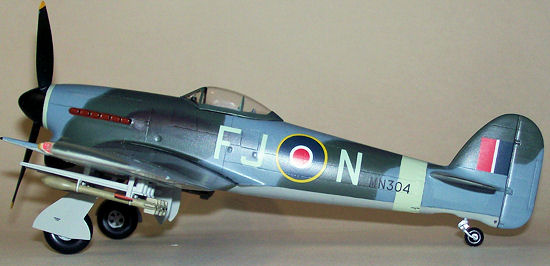 On August 6th Sqn Ldr Beake led
an attack on a quarry. The day after he took a 48 hs leave and upon his return
164 Sqn (August 9th) attacked time and time again a dump that finally
was destroyed on August 11th. This task being successfully carried
out, the squadron started their offensive recco missions. On the 13th
Wing commander Walter Dring summoned Beake and informed him that that had been
his last op in the following words: “Beaky, you have just done your last op. You
are not to fly again and that is an order, until returning to the UK. I am
arranging for your relief as soon as possible”. Stunned and embarrassed of
sending his squadron to action but not being able to fly with them he was
finally replaced by the New Zealander Sqn Leader Ian Waddy.
On August 6th Sqn Ldr Beake led
an attack on a quarry. The day after he took a 48 hs leave and upon his return
164 Sqn (August 9th) attacked time and time again a dump that finally
was destroyed on August 11th. This task being successfully carried
out, the squadron started their offensive recco missions. On the 13th
Wing commander Walter Dring summoned Beake and informed him that that had been
his last op in the following words: “Beaky, you have just done your last op. You
are not to fly again and that is an order, until returning to the UK. I am
arranging for your relief as soon as possible”. Stunned and embarrassed of
sending his squadron to action but not being able to fly with them he was
finally replaced by the New Zealander Sqn Leader Ian Waddy.
Just 3 days after taking command of the
Squadron, Ian Waddy was shot down and killed by flak.
F/L A. Napier,
On 18 August 164 Sqn took part
in a four-squadron attack on German armour at Chambois, during the battle of the
Falais pocket, helping to destroy a force of around 100 armoured vehicles.
On August 20th the famous Belgian
ace Remmy “Buzzy” Van Lierde (
Five days later tragedy again hit the
squadron when F/O G Trafford and F/S R. White were shot down and killed.
“Buzzy” flew his first mission with 164 Sqn
on August 30th. The following day his plane was hit by flak in the
mainplane during a mission against yet another radar site but he made it back to
base.
The squadron made the following moves during
September: B.23 Morainville, B.35 Baromesnil, B.53
Merville.
Between September 6th and 22nd
164 Sqn attacked guns positions in the Le Havre, Boulogne, Calais, Niuport and
Cap Gris Nez.
On September 23rd 164 Sqn was
flying over Boulogne and when getting ready to attack, the Germans positions
surrendered. The loudspeakers inviting them to do so plus the sight of the
circling Typhoons was too much to bear.
The Army sent a congratulatory message to
the Squadron when they destroyed an old fort West of Calais on the 26th
After the breakout moved
forward through northern France and Belgium in support of the 21st Army Group.
For the remaining months of the war, the squadron was engaged in reconnaissance
sweeps, attacking enemy transport and tanks.
Between October and November
1944 164 Sqn was based at B.67 Ursel
On Saturday
October 7, 1944, during Operation "Switchback" as the Canadian Army was
attacking one of the last German pockets of resistance in Belgium, 164 Sqn gave
direct support. The pilot of Typhoon MN-862 reported that his engine was giving
him trouble (most likely he had been hit by flak). The plane crashed and
exploded near Damme (Belgium) with F/S James Teather still inside. His body was
found one month later by the Allies advancing in the area. Teather had taken
part in the successful attacks in the Calais and Boulogne area and was
responsible of the destruction of the fort that earned the Squadron the message
from the Army on the 26th. A headstone was placed and the text was
written was his widow. It reads:
 “He lived and
died for those he loved
“He lived and
died for those he loved
And those he loved remember”
Sadly his
son was born 20 days after Teather was killed. Late in the 90s Teather’s watch
was recovered from the site by a Belgian and returned to his widow who visited
the crash site for the occasion.
In January Van Lierde was
replaced by Sqn Ldr P.L. Bateman Jones.
One of the most important
characters of the squadron was Bill Bags from Canada. He flew more than 100
sorties with 164 Sqn. When he joined the Squadron he was surprised that it was
an Argentine-British one as he was under the impression that the Argentines were
Nazi sympathizers. But he found a band of brothers that came from all over the
world:
Belgian, Frenchmen, Poles,
South Africans, Rhodesians, and an American. When he was rested he was sent as
forward air controller in a tank of the 4th Canadian Armoured Brigade. From his
tank he would lead his fellow airmen to attack targets that were, in some cases,
less than 100 yards away from his position. He later commented that this
assignment was scarier than flying his Typhoon. Bill Bags
When the war in Europe ended 164 Sqn was sent back to the UK where it received No.453 Squadron's Spitfires, before being renumbered as No.63 Squadron on 31 August 1946.
| THE KIT |
This is the 1969
issued kit molded in dark green plastic. Profile of the plane is very accurate
(though the tail is not as rounded as it should be), raised (and incorrect)
panel lines, spartan cockpit, only one option of awful decals (you can see the
pixels/dots in the dark colours).
| CONSTRUCTION |
This one of the first kits I painted with an airbrush back in Argentina in the 90s. It came to Canada along with other model planes when we moved here and suffered at the hands of the Customs Agents who opened the boxes and messed with the kits. As a consequence this Typhoon lost one cannon, the canopy. When I checked the kit the undersides (especially) had yellowed because I used to use the Humbrol clear varnish.
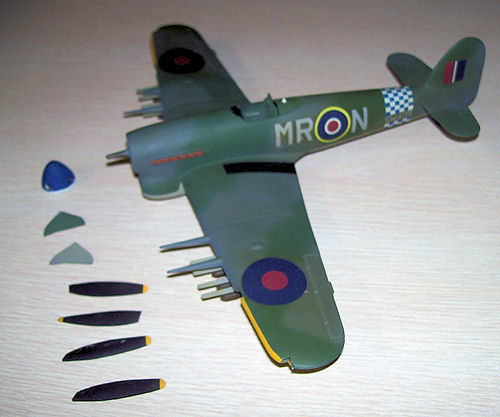 I decided to re
construct the plane and give it a second life, this time as one of the planes of
164 Sqn.
I decided to re
construct the plane and give it a second life, this time as one of the planes of
164 Sqn.
First I left the
kit in bleach for several days but it looks like the layers of paint and varnish
were very thick as I was barely able to remove paint even using an old tooth
brush (in other kits the Humbrol paints would just fall off like sand). So I
decided to go with a more drastic approach: oven cleaner. I first unglued the
landing lights and wing tip lights as the product would make them dull.
It took an
entire can of cleaner to remove the paint. Not so much because of the paint
itself but because the decals now were protecting the paint underneath and the
oven cleaner did not even scratched them!
As this plane is
based on the only surviving one when it was based in the US in the 60s and
incorrectly (for most of the planes) it has the plate around the exhaust stacks,
I sanded it out.
This
accomplished I re-scribed all the panel lines using the scale planes in the
Valiant book Hawker Typhoon by Richard A. Franks. This was the first time I
tackled this approach and I got some input by the more than skillful Tony Bell.
I made copies of the scale planes in 1/48 and proceeded to cut out each panel
carefully. This panel was put in place using masking tape and Dymo tape bordered
it. The pieced of paper was lifted out and then the panel line marked with an
Xcto knife (10). This process took several days.
There were som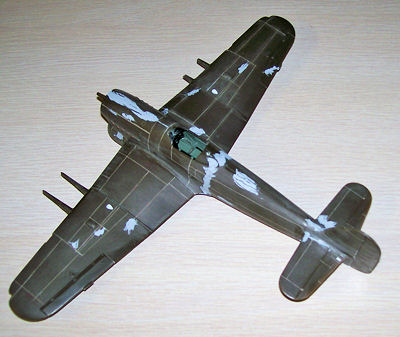 e
areas that I had properly fixed in the past using putty, but others that I had
overlooked were taken care of this time (i.e. ejection marks under the tail
planes). In other cases my panel lines had gone a little bit too long and had to
be covered with putty as well.
e
areas that I had properly fixed in the past using putty, but others that I had
overlooked were taken care of this time (i.e. ejection marks under the tail
planes). In other cases my panel lines had gone a little bit too long and had to
be covered with putty as well.
One blare
omission in the original kit is the lack cylindrical tanks inside the wheel
wells. Using unused tropical filters from some Hobbycrafts Bf109s
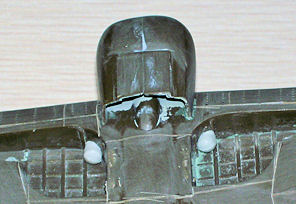 that were cut
in length I was able to replicate these missing parts.
that were cut
in length I was able to replicate these missing parts.
Another thing that is missing is the very subtle humps on the inward cannons. Again using the scale plans I cut out a very thin strip of Evergreen, glued it, sanded the edges to merge them with the surface of the wing and added some putty here and there to improve the union. The missing cannon came from a Hasegawa Typhoon kit (as I am planning on converting the car door kit into an early MK1a).
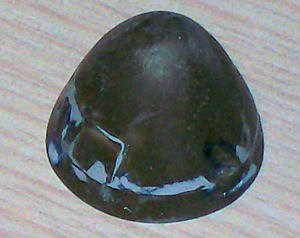 The planes flown
by 164 Sqn were three propelled and the kit has four. So I did some major
surgery to the hub by cutting out the 4 bases, aligning 3 of them using the
scale plans, and covering the resulting gaps with pieces of plastic that were
left. Some putty and sanding took care of the imperfections and I ended up with
a 3 blade propeller.
The planes flown
by 164 Sqn were three propelled and the kit has four. So I did some major
surgery to the hub by cutting out the 4 bases, aligning 3 of them using the
scale plans, and covering the resulting gaps with pieces of plastic that were
left. Some putty and sanding took care of the imperfections and I ended up with
a 3 blade propeller.
The tip of the
tail was sanded to round it and achieve the correct profile. The seat (quite
inaccurate I read it is) fell off from the cockpit. The plane was ready for
painting after washing it with water and soap.
| COLORS & MARKINGS |
I sprayed the spinner and the fuselage band
with Modelmaster RAF sky. The leading edge of the wings and propeller tips
received a very nice coat of yellow (MM Acryl 4721). I then masked the leading
edge in a way that exposed the yellow. I then covered the yellow edge with
masking tape and removed the first band of masking tape. This allowed me to have
the correct profile for the yellow bands and at the same time, having painted it
over the sky color, saved me the headache of giving the edges layer after layer
of yellow to try to cover the cammo colours. It is a backwards process that
takes more time (twice masking) but delivers better results.
I used Model Master Acryl 4759 for the
inferior surfaces and the entire kit to check for imperfections during my
re-scribing process. Once the undersides and the band were masked with Tamiya
tape and paper I airbrushed the darker gray for the fuselage and wings using
Model Master Acryl 4746. To correctly describe the cammo I made copies of the
profiles in the Valiant
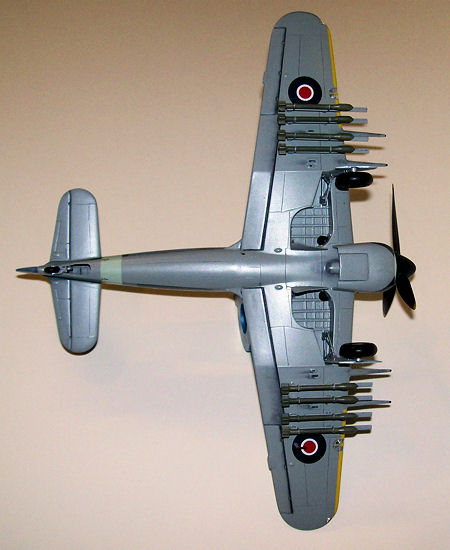 book color plans, cut them and attached them using
masking tape. Then worms of Blue tac added to the edge of the paper masks helped
to achieve a soft demarcation. Once this was done a coat of Model Master Acryl
RAF Dark Green finished the cammo.
book color plans, cut them and attached them using
masking tape. Then worms of Blue tac added to the edge of the paper masks helped
to achieve a soft demarcation. Once this was done a coat of Model Master Acryl
RAF Dark Green finished the cammo.
Rockets and rails were also painted in light
gray, along with the landing gear doors. The pad inside the landing gear doors
received a coat of aluminum.
My usual technique of sanding black pastel
and applying it to some areas with a brush delivered some wear and depth
(moveable surfaces). A silver pen created an effect of chipped paint especially
around fasteners, walking area on wings and edge of panels.
Stains behind the exhausts were created
using a mix of rust and black-sanded pastels and a brush (I believe I overdid
these). These were also used to get the undersides a little bit dirty.
Landing lights were given a coat of Future
and the demarcation line was painted half in yellow and half in underside gray.
The intake was painted in diluted black that
pooled only on the recesses thus making the grid stand out. The interior face of
the intake was painted following the camouflage in that area.
The main landing gear was glued in place as
support for the plane during the process of applying Future.
After the layers of Future were applied the
plane was ready for the decals.
All stencils
were copied from the Hasegawa kit in clear decals and applied. Main decals were
Super Scale 48-541 decals for roundels and tail bands, Aeromaster 48-237 for the
Sky letters. They all went on with no problem and acted properly to the Set/Sol
combination.
A coat of semi-gloss Model Master Acryl varnish protects the decals.
| FINAL CONSTRUCTION |
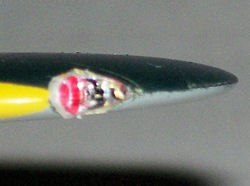 I worked the
undersides outwards: added small landing gear doors, rockets, landing lights and
wingtip lights.
From the spares box I retrieved a Venturi that I glued under the wing after
painting it in grey and rust.
I worked the
undersides outwards: added small landing gear doors, rockets, landing lights and
wingtip lights.
From the spares box I retrieved a Venturi that I glued under the wing after
painting it in grey and rust.
I removed the masking tape from the vacuum formed canopy. The prepainted seat belts were added to the seat and this one was carefully wriggled inside the cockpit sides. The light behind the seat received a couple of drops of chrome silver.
The two pouches than contain the tools for the landing gear were made of brown painted masking tape and stuck to the back walls of the wheel wells.
The gun
sight was
cut out from a thin sheet of clear film. The reflective light was made with a
drop of chrome silver and the gun sight was glued in place.
The canopy was
attached carefully using Testors glue after scratching its contour on the
fuselage paint.
I had set aside the unused decals from the SMER SM79 to use some large black bands this sheet has…only to put them away in one day of confusion pondering why had I left the decals aside…With the plane finished…I realized that I had forgotten to add the anti-slipping black bands on the wing roots…and those black SMER decals were going to be used for the anti-slipping bands! So out came the decals but they are quite old and they fell apart easily and attached themselves to the kit firmly. So the fact that they cracked here and there was useful as it gave the bands a worn out look. With this accomplished my Typhoon was finished.
| CONCLUSIONS |
It has been
clearly superseded by the Hasegawa offering in terms of details but still makes
a nice Tyffie. This has been the last of the 3-part series about the little
known164 Sqn.

Thanks to:
Sqn. Ldr.
Percival Beake
Anthony Knight (Secretary,
TECT = Typhoon Entente Cordiale Trust) for all his help to get in touch with Mr.
Beake, his support and kindness to use text from the TECT (Typhoon Entente
Cordiale Trust). Highly recommended if you are a fan of the old or new Typhoon!
You can visit them at www.tect.org.uk
| REFERENCES |
·
TECT- Newsletter
1 Spring 2011
·
Alas de Trueno
(Claudio Meunier)
·
The Hawker
Typhoon by Richard A. Franks (Valiant)
·
·
http://www.thememoryproject.com/stories/654:bill-mitchell-baggs/
·
Royal Air Force
website: History RAF Formations – 164 Sqn
·
Regimental-Art.com (Percival Beake)
·
The Hawker
Tempest Page (www.hawkertempest.se)
·
Nijmegen
Market-Garden Veterans’ website
http://home.kpn.nl/been0319/stories6.html
Pablo Calcaterra
November 2012
Thanks to for the preview kit. You can find this kit at your favorite hobby shop or on-line retailer.
If you would like your product reviewed fairly and fairly quickly, please contact the editor or see other details in the Note to Contributors.